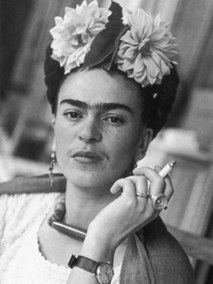 Frida Kahlo de Rivera, born in Mexico City as Magdalena Carmen Frida Kahlo y Calderon on July 6, 1907, is best known and remembered for her colorfully vibrant and frequently intense self-portraits, despite the fact that she never originally planned to become an artist and painter. The third of four sisters and half-sisters raised in their family home affectionately known as La Casa Azul (The Blue House), Frida’s father was European, while her mother was of Spanish and Mexican Indian descent. Frida’s childhood goal was to become a doctor, due to her suffering progressively worse health problems throughout her lifetime. At age six, she contracted polio, a condition that left her legs unevenly contorted. In spite of this, she often participated in physically strenuous sports such as boxing, and came to hide her disability by wearing long, full skirts. By the age of 15, Frida was one of only 35 girls attending one of Mexico’s oldest and most elite high schools, La Escuela Nacional Preparatoria (The National Preparatory School). While riding the bus a few years later, however, Frida suffered through multiple serious injuries because the bus collided with a trolley. The fatal accident left her with severely broken bones and fractures, from her spinal column to her ribs and pelvis. Her health deteriorated as she quickly underwent reconstructive surgeries, many of them furthering medical complications that affected her ability to move for months. Her abdomen and uterus also suffered grave damage from the accident, later compromising her reproductive capacity as an adult. It was during this phase of temporary immobility that Frida abandoned her dreams of pursuing medicine, finding herself beginning to paint to keep herself occupied and less lonely during her recovery. Her mother created a special easel for Frida to paint comfortably from her bed, while her father let her borrow his oil paints and paintbrushes. She often shared that it was a painful period in her life, and her paintings -- the majority of them dramatic, primitive yet symbolic self-portraits -- reflected her physical and psychological wounds. While Frida’s relationship with her father was amicable, being surrounded by women all her life undoubtedly influenced her growing sense of feminism significantly. Throughout the years, Frida came to embrace and identify with her maternal Mexican roots and heritage, evidenced through her vigorous (and at times, dangerous) political activities as she became an adult. It has been reported that she even started to claim her birthday as July 7, 1910, to reflect the beginning of the Mexican Revolution and modern Mexico as her very own birth. As a budding young artist filled with passion, Frida’s fiery nature soon found an equal in Diego Rivera, a prominent Mexican painter at the time, whom she initially reached out to for guidance and advice regarding pursuing an artistic career. Recognizing her talent, Rivera encouraged her to continue developing her art and painting style. Their artistic pursuits, as well as political ideals, lead both towards an intimate relationship with each other. They soon married, in spite of Frida being only 19 years old at the time. They divorced and remarried each other a decade later, despite their tempestuous temperaments and history of numerous extramarital affairs on both sides. Frida died at the age of 47, and the exact cause of death is still unknown. She often voiced that she did not wish to be buried, having been confined to her bed for so many years throughout her life. She was instead publicly cremated, her ashes still on display today at her former family home, La Casa Azul, which has been transformed into a museum displaying various mementos, artifacts and works from Frida’s personal life since 1958. While Kahlo only exhibited her paintings once in the United States, in 1938, her work received wide acclaim by artists worldwide, including one of her paintings, The Frame, being purchased and displayed at The Louvre in Paris, France, at the time. Although she was often posthumously referred to as Diego Rivera’s wife, her unique artistic style became renowned in the 1980s as more Mexican artists gained more recognition among the public across the globe. Comments are closed.
|
Archives
July 2017
Categories
All
|
 RSS Feed
RSS Feed